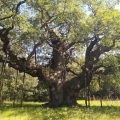Alternative futures for nature based solutions in the UK
The conservation sector must engage to ensure that benefits beyond carbon are delivered
There are two types of solutions to climate change – technological and ecological. The former class includes developing the necessary pathways to reducing greenhouse gas emissions to prevent global warming. Yet, while Nature delivers a host of benefits without which people cannot survive — oxygen, water and countless other nutrient cycles are all driven by the thin film of life that covers the planet — its capacity to draw carbon from the atmosphere has drawn attention as technology’s complement in meeting the global Net Zero ambition.
The role that natural systems play in balancing atmospheric inputs and outputs has created a political battleground. In the UK’s last General Election, the rhetoric around Brexit (how much better or worse off we would be by leaving the European Union) was interspersed with bluster around action on climate change. A simple, charismatic metric soon emerged from the clamour: political leaders found themselves in a bidding war over how many trees they would plant if they were elected.
Tree planting, or more precisely woodland creation, is seen in a generally positive light. Trees capture and store carbon, but they can also stabilise soils, provide fibre, food and fuel, shelter for livestock and crops, and harbour the wildlife both noticed and unnoticed that provides us with services as utilitarian as pollination of crops and as intractable as mental wellbeing.
The need for trees
So good are trees at doing all of these things that the Committee on Climate Change, the advisory body to the UK government, called for an increase in national woodland cover from 13 to 17 percent by 2050 as an essential component of the overall national response to emissions reduction. That works out at an unprecedented, sustained campaign of around 30,000 hectares annually for the next 20 years, raising some uncomfortable, as yet unanswered, logistical challenges, such as where the trees would go, where the seeds will come from and how it all gets paid for.
Not all woodland is the same. Arrow-straight lines of single non-native conifer species grow quick and tall, providing timber, pulp and biomass as the fastest way to lock up carbon, yet sometimes at the expense of biodiversity and the acidification of water tables. Native woodland, of primarily broadleaved, deciduous species, provides habitat for the wildlife with which it has co-evolved over millennia. For that wildlife to respond to a changing climate, it’s essential to provide new areas of tree canopy, enabling movement across the landscape to more habitable places.
This provides a single example, of which there are many, in which an investor faces a dilemma: put the money into quick carbon, or into slow carbon-with-benefits. To make the case for native woodlands, the focus has shifted to the additional ecosystem services they provide, such as natural flood management and the provision of year-round forage for pollinators, and the economic value of those services. But the case needs to be made with passion, a virtue that economists are not often noted for.
Meeting two challenges
Outcomes that address both climate change and the biodiversity crisis are possible but it’s a cold hard fact that the money to stop global warming will ultimately come from business: it’s another that there isn’t a similar fund for nature. Business investors need to see that there is more at stake in their lifetimes than carbon and that genuine extra value can be derived from projects that deliver for biodiversity too. But who will show them? Not the commercial forester who seeks to maximise the tonnage of biomass at a site, any more than the farmer who seeks to maximise crop yields by blitzing the land with fossil-derived fertilisers.
The conservation NGO sector holds the key to meeting both challenges at the same time. By positively engaging with the natural capital narrative, however distasteful the terminology might sometimes be, the vast pool of expertise needed to restore functional natural ecosystems can be rightly drawn upon. By ignoring that narrative, the risk is that the United Nations’ International Decade of Ecological Restoration will prove to be the missed opportunity that presages the sixth mass extinction event in the Earth’s history, the first caused by a single species.



